ATK-2 Aeorological Theodolite (pibal theodolite)
This theodolite produced in the Soviet Union in 1961.
The ATK-2 is the oldest Soviet Theodolite design I have encountered. The designation "ATK-2" implies that the existence of an "ATK" model which would presumably predate this model.
The ATK-2 is similar in size to the other Soviet (Russian) theodolites but a bit heavier. Still much lighter than an American pilot balloon theodolite by a significant margin. This theodolite uses 60 part verniers, yielding 1 minute resolution. The circles read to one degree.
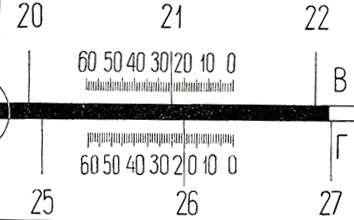
The circles and verniers are superimposed into the eyepiece focused at infinity, so the observer does not need to loose site of the item being tracked in order to see the azimuth and elevation readings. This theodolite has a rather complex optical path. It uses glass circles unlike the later Soviet theodolites on this site which use metal circles.
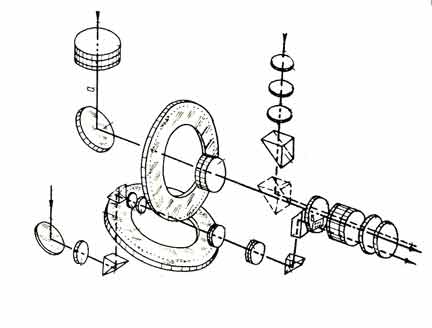
The theodolite offers illumination for low light viewing including an internal rheostat. The tripod mount is the modern tribrach type. The theodolite has a screw on compass, and lacks the internal switchable filters of later Soviet designs. This theodolite is very compact and fairly light yet features a large 40mm main objective (18 power), 10mm finder scope (3.2 power) and gun site. It included a manual and tools and a compact square case similar in size to a lunch box.
The theodolite is worm driven does not have a slip clutch mechanism. The worm drives can be disengaged by rotating a spring loaded knob that is concentric with the worm drive screws. The mechanism can be locked in the disengaged position.
A unique aspect of this theodolite is that the reticule assembly is mechanically connected to the body of the theodolite not to the eyepiece tube. This allows the cross to maintain its vertical orientation regardless of the elevation of the telescope.
The manual included with the theodolite is quite lengthy. It contains highly detailed specifications, parts and cutaway illustrations and most likely instructions for pilot balloon tracking. However it is written in Russian and I have no access to a translator presently.
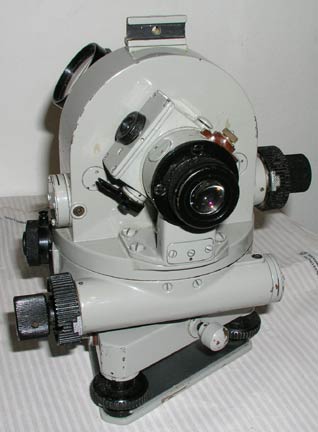 |
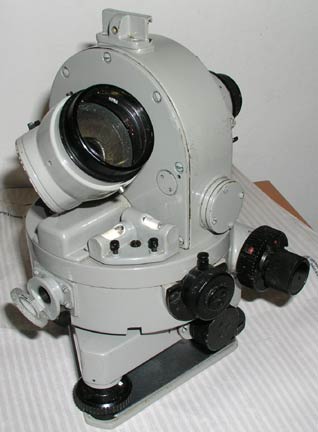 |
In the photo above left you can see the concentric knobs for rotating the worm screw (inner knob) and engaging the worms (outer ring) In the photo above right you can see the bottom knob for the rheostat, above that is the knob for setting the azimuth circle to match the compass, to the left of that the mirror to illuminate the circles. A lamp inserts into the hole adjacent to the mirror for night time operation.
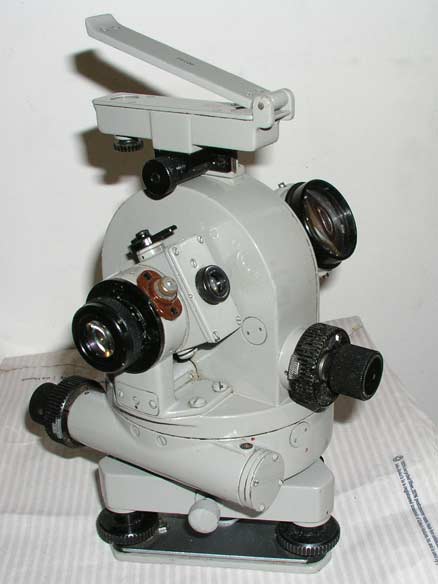
Photo above with compass attached, brown part near eyepiece is the reticule lamp holder.
| Drive Type | Positive/Worm | Compass | Yes |
| Display Type | Vernier
to 1 minute (viewed in eyepiece) |
Levels | 2, body, bubble tube |
| Main Telescope | 40 mm 18x | Mounting | Tribrach |
| Finder Telescope | 10mm
3..2x single eyepiece |
Illumination | 2, 3
Volt incandescent, scales reticule |
| Gun Site | Yes 1, main telescope | Weight | 4.7kg |
